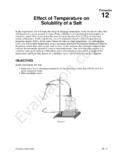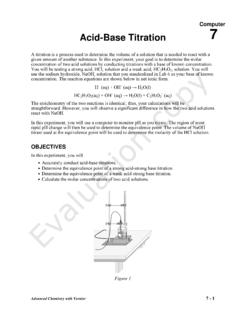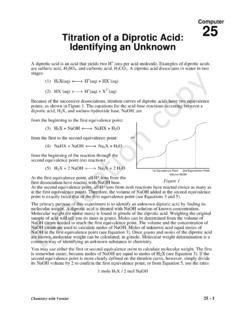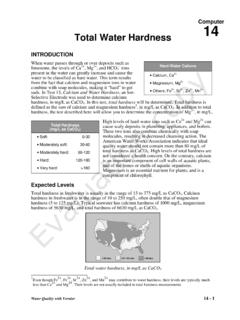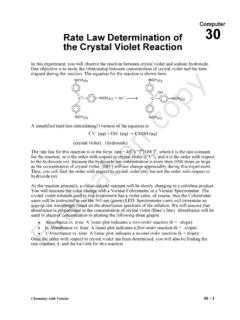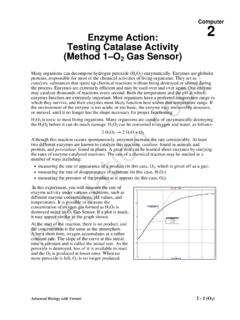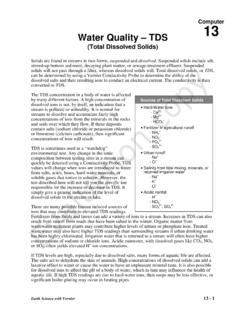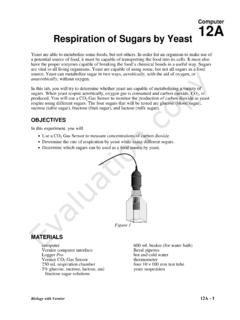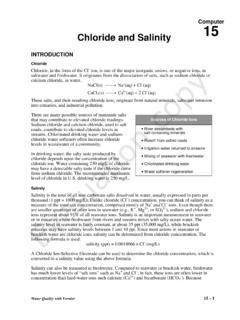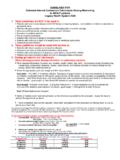Transcription of Computer 16B Effect of Temperature on Fermentation copy
1 Computer 16B Biology with Vernier 16B - 1 Effect of Temperature on Fermentation Temperature changes have profound effects upon living things. Enzyme-catalyzed reactions are especially sensitive to small changes in Temperature . Because of this, the metabolism of poikilotherms, organisms whose internal body Temperature is determined by their surroundings, are often determined by the surrounding Temperature . Bakers who use yeast in their bread making are very aware of this. Yeast is used to leaven bread (make it rise). Yeast leavens bread by fermenting sugar, producing carbon dioxide, CO2, as a waste product.
2 Some of the carbon dioxide is trapped by the dough and forms small air pockets that make the bread light. If the yeast is not warmed properly, it will not be of much use as a leavening agent; the yeast cells will burn sugar much too slowly. In this experiment, you will watch yeast cells ferment (burn sugar in the absence of oxygen) at different temperatures and measure their rates of Fermentation . Each team will be assigned one Temperature and will share their results with other class members. You will observe the yeast under anaerobic conditions and monitor the change in air pressure due to CO2 released by the yeast. When yeast burn sugar under anaerobic conditions, ethanol (ethyl alcohol) and CO2 are released as shown by the following equation: C6H12O6 2 CH3CH2OH + 2 CO2 + energy glucose ethanol carbon dioxide Thus, the metabolic activity of yeast may be measured by monitoring the pressure of gas in the test tube.
3 If the yeast were to respire aerobically, there would be no change in the pressure of gas in the test tube, because oxygen gas would be consumed at the same rate as CO2 is produced. OBJECTIVES In this experiment, you will Use a Gas Pressure Sensor to measure the change in pressure due to carbon dioxide released during respiration. Determine the rate of Fermentation of yeast at different temperatures . MATERIALS Computer vegetable oil in a dropper bottle Vernier Computer interface 1-hole rubber stopper assembly Logger Pro plastic tubing w/Luer-lock fitting Vernier Gas Pressure Sensor pipet pump or bulb 5% glucose solution ring stand 1 liter beaker (for water bath) thermometer Beral pipet, graduated basting bulb or Beral pipet 10 mL graduated cylinder utility clamp 18 150 mm test tube warm and cool water yeast suspension Evaluation copyComputer 16B 16B - 2 Biology with Vernier Figure 1 PROCEDURE 1.
4 Connect the Gas Pressure Sensor to the Computer interface. Prepare the Computer for data collection by opening the file 16B temp -Ferment (Pressure) from the Biology with Vernier folder of Logger Pro. 2. Connect the plastic tubing to the valve on the Gas Pressure Sensor. 3. Prepare a water bath for the yeast. A water bath is simply a large beaker of water at a certain Temperature . This ensures that the yeast will remain at a constant and controlled Temperature . To prepare the water bath, obtain some warm and cool water from your teacher. Combine the warm and cool water into the 1 liter beaker until it reaches the Temperature you were assigned. The beaker should be filled with about 600 700 mL water. Place the thermometer in the water bath to monitor the Temperature during the experiment. 4. Place mL of the glucose solution into a clean 18 150 mm test tube.
5 5. Obtain the yeast suspension. Gently swirl the yeast suspension to mix the yeast that settles to the bottom. Using a 10 mL pipette or graduated cylinder, transfer mL of yeast into the test tube. Gently mix the yeast into the sugar solution. Be gentle with the yeast they are living organisms! 6. In the test tube, place enough vegetable oil to completely cover the surface of the yeast/glucose mixture as shown in Figure 2. Be careful to not get oil on the inside wall of the test tube. Set the test tube in the water bath. 7. Insert the single-holed rubber-stopper into the test tube. Note: Firmly twist the stopper for an airtight fit. Secure the test tube with a utility clamp and ring-stand as shown in Figure 1. Yeast/glucoseVegetableoil Figure 2 Effect of Temperature on Fermentation Biology with Vernier 16B - 3 8. Incubate the test tube for 10 minutes in the water bath.
6 Be sure to keep the Temperature of the water bath constant. If you need to add more hot or cold water, first remove about as much water as you will be adding, or the beaker may overflow. Use a basting bulb to remove excess water. Note: Be sure that most of the test tube is completely covered by the water in the water bath. The Temperature of the air in the tube must be constant for this experiment to work well. 9. When incubation has finished, connect the free-end of the plastic tubing to the connector in the rubber stopper as shown in Figure 3. 10. Click to begin data collection. Maintain the Temperature of the water bath during the course of the experiment. Data will be collected for 15 minutes. 11. Monitor the pressure readings displayed in the meter. If the pressure exceeds 130 kPa, the pressure inside the tube will be too great and the rubber stopper is likely to pop off.
7 Disconnect the plastic tubing from the Gas Pressure Sensor if the pressure exceeds 130 kPa. 12. When data collection has finished, disconnect the plastic tubing connector from the rubber stopper. Remove the rubber stopper from the test tube and discard the contents in a waste beaker. 13. Find the rate of Fermentation : a. Move the mouse pointer to the point where the pressure values begin to increase. Hold down the mouse button. Drag the mouse pointer to the position where the data values cease to rise and release the mouse button. b. Click the Linear Fit button, , to perform a linear regression. A floating box will appear with the formula for a best fit line. c. Record the slope of the line, m, as the rate of Fermentation in Table 1. d. Close the linear regression floating box. e. Share your data with other classmates by recording the Temperature and the rate of Fermentation on the board.
8 PROCESSING THE DATA 1. Record the data from the other teams in Table 2. 2. On Page 2 of the experiment file, create a graph of Fermentation rate vs. Temperature using the data recorded in Table 2. The Fermentation rate values should be plotted on the y-axis, and the Temperature on the x-axis. DATA Table 1: Team Data Temperature ( C) Rate of Fermentation (kPa/min) Figure 3 Computer 16B 16B - 4 Biology with Vernier Table 2: Class Data Temperature ( C) Rate of Fermentation (kPa/min) QUESTIONS 1. On the basis of the results of this experiment, does Temperature affect the rate of Fermentation of yeast? Explain. 2. Is there an optimal Temperature for yeast to ferment sugar? How does this compare to the Temperature yeast are at when rising while making bread? You may have to consult a cookbook to answer this. 3. Why does the Fermentation rate decrease at very high temperatures ?
9 4. It is sometimes said that the metabolism of poikilotherms doubles with every 10 C increase in Temperature . Does your data support this statement? Explain. 5. What is the purpose of the oil on top of the water? 6. Do yeast always live in conditions where their consumption of energy is optimal? Explain. 7. Why do you need to incubate the yeast before you start monitoring air pressure? 8. Yeast live in many different environments. Make a list of some locations where yeast might naturally grow. Estimate the temperatures of each of these locations and compare them to your results. Vernier Lab Safety Instructions Disclaimer THIS IS AN EVALUATION copy OF THE VERNIER STUDENT LAB. This copy does not include: z Safety information z Essential instructor background information z Directions for preparing solutions z Important tips for successfully doing these labs The complete Biology with Vernier lab manual includes 31 labs and essential teacher information.
10 The full lab book is available for purchase at: Vernier Software & Technology 13979 Millikan Way Beaverton, OR 97005-2886 Toll Free (888) 837-6437 (503) 277-2299 FAX (503) 277-2440
